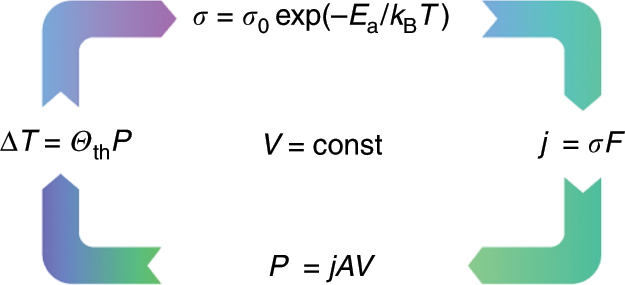Light: Science & Applications ( IF 20.6 ) Pub Date : 2020-01-10 , DOI: 10.1038/s41377-019-0236-9 Anton Kirch 1 , Axel Fischer 1 , Matthias Liero 2 , Jürgen Fuhrmann 2 , Annegret Glitzky 2 , Sebastian Reineke 1

|
Organic light-emitting diodes (OLEDs) have become a major pixel technology in the display sector, with products spanning the entire range of current panel sizes. The ability to freely scale the active area to large and random surfaces paired with flexible substrates provides additional application scenarios for OLEDs in the general lighting, automotive, and signage sectors. These applications require higher brightness and, thus, current density operation compared to the specifications needed for general displays. As extended transparent electrodes pose a significant ohmic resistance, OLEDs suffering from Joule self-heating exhibit spatial inhomogeneities in electrical potential, current density, and hence luminance. In this article, we provide experimental proof of the theoretical prediction that OLEDs will display regions of decreasing luminance with increasing driving current. With a two-dimensional OLED model, we can conclude that these regions are switched back locally in voltage as well as current due to insufficient lateral thermal coupling. Experimentally, we demonstrate this effect in lab-scale devices and derive that it becomes more severe with increasing pixel size, which implies its significance for large-area, high-brightness use cases of OLEDs. Equally, these non-linear switching effects cannot be ignored with respect to the long-term operation and stability of OLEDs; in particular, they might be important for the understanding of sudden-death scenarios.
中文翻译:

OLED 中焦耳热引起的切换回区域的实验证明
有机发光二极管 (OLED) 已成为显示领域的主要像素技术,产品涵盖当前面板尺寸的整个范围。将有源区域自由缩放到与柔性基板配对的大而随机表面的能力为普通照明、汽车和标牌领域的 OLED 提供了额外的应用场景。与一般显示器所需的规格相比,这些应用需要更高的亮度,因此需要更高的电流密度操作。由于扩展的透明电极会产生显着的欧姆电阻,因此遭受焦耳自热的 OLED 在电势、电流密度和亮度方面表现出空间不均匀性。在这篇文章中,我们提供了理论预测的实验证明,即 OLED 将随着驱动电流的增加显示亮度降低的区域。使用二维 OLED 模型,我们可以得出结论,由于横向热耦合不足,这些区域在电压和电流上局部切换回。在实验上,我们在实验室规模的设备中证明了这种效应,并得出随着像素尺寸的增加它会变得更加严重,这意味着它对于 OLED 的大面积、高亮度用例具有重要意义。同样,这些非线性开关效应对于 OLED 的长期运行和稳定性也不容忽视;特别是,它们可能对理解猝死场景很重要。我们可以得出结论,由于横向热耦合不足,这些区域在电压和电流上局部切换回。在实验上,我们在实验室规模的设备中证明了这种效应,并得出随着像素尺寸的增加它会变得更加严重,这意味着它对于 OLED 的大面积、高亮度用例具有重要意义。同样,这些非线性开关效应对于 OLED 的长期运行和稳定性也不容忽视;特别是,它们可能对理解猝死场景很重要。我们可以得出结论,由于横向热耦合不足,这些区域在电压和电流上局部切换回。在实验上,我们在实验室规模的设备中证明了这种效应,并得出随着像素尺寸的增加它会变得更加严重,这意味着它对于 OLED 的大面积、高亮度用例具有重要意义。同样,这些非线性开关效应对于 OLED 的长期运行和稳定性也不容忽视;特别是,它们可能对理解猝死场景很重要。OLED的高亮度用例。同样,这些非线性开关效应对于 OLED 的长期运行和稳定性也不容忽视;特别是,它们可能对理解猝死场景很重要。OLED的高亮度用例。同样,这些非线性开关效应对于 OLED 的长期运行和稳定性也不容忽视;特别是,它们可能对理解猝死场景很重要。











































 京公网安备 11010802027423号
京公网安备 11010802027423号